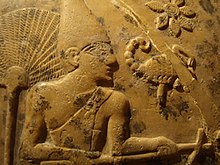Horus Scorpion II
Horus Scorpion II (hor Serq) was a ruler of Ancient Egypt, belonging to the so-called Dynasty 0. His spouse's name was Shesh I, mother of Narmer and great-grandmother of another queen, Shesh II.
Although the data on Horus Scorpion are imprecise, his existence is even doubted, he would have lived around the year 3170 B.C. C., since the Narmer Palette, which reflects the invasion of Lower Egypt by his son Narmer, is dated 3150 BC. c.
The Ceremonial Mace
The existence of Horus Scorpion II seems confirmed by a limestone "ceremonial mace head", discovered in a temple at Hierakonpolis during the 1897/98 excavation period by archaeologists James Edward Quibell and Frederick William Green, in the one that shows a large pharaoh, with the White crown of Upper Egypt and the image of a scorpion engraved next to his head.
This mace, housed in the Ashmolean Museum, is one of the oldest depictions of an Egyptian king. It belongs to a time when writing was incipient, with a scorpion being engraved next to the king, as a hieroglyph, which would represent the name of the pharaoh. The stratigraphic level of this mace has been lost due to the excavation methods used, but its style indicates a date to the late Predynastic period. Although badly damaged, the visible parts are remarkable records of this early Egyptian history, indicating that Horus Scorpion would have lived before or during the Narmer empire in Tinis.
A fragment of a second, smaller mace, known as the Little Scorpion Ceremonial Macehead, was also found. Although the fragment is not very large, it clearly shows the pharaoh wearing the Red Crown of Lower Egypt.
In one of the vases dedicated by him in Hierakonpolis, he is accompanied by the Horus falcon, symbol of Egyptian royalty.
Interpretation
It has been wanted to interpret this as evidence of the existence of a ruler named Horus Scorpion II, who would have carried out the unification of Ancient Egypt or its beginning, since according to tradition it was carried out later, around the year 3170 BC. C., when the rulers of Upper Egypt dominated Lower Egypt.
Horus Scorpion carries a hoe in his hand, which is related to the religious rites about the opening of the dykes after the flooding of the Nile, or the first furrow in the field. The banners, with birds –specifically lapwings or the ave rejit–, would symbolize the nomes or implied populations of Egypt; several papyrus plants indicate that the event took place in Lower Egypt; there is also a flower with seven petals at the top, difficult to interpret. The nine arches (representing the traditional enemies of the Egyptians) are interpreted as proof that the attacks that culminated in the unification of Narmer began in Lower Egypt.
The Tomb of Horus Scorpion II
His tomb could be the one located in Umm el-Qaab, Abydos, called B-50.
Royal succession order
For the Egyptologists Werner Kaiser and Günter Dreyer, this king is the successor of Horus Ka and the predecessor of Narmer.
Degree
| Titulatura | Jeoglyphic | Transliteration (transcription) - translation - (references) |
| Name of Horus: |
| ḥr srḳ (hor Serq) Horus scorpion (Hieracompolis) |
In popular culture
- The short novel The Scorpion God of William Golding (1971) is freely based on this period of Egypt.
- The name of Scorpion King is used in the film The Mummy Returns (2001) and its spin-off The Scorpion King (2002) and the Scorpion King: the rise of a warrior (2008).
- Video game for Nintendo GameCube The Scorpion King: Rise of the Akkadian is based on the 2002 film.
- The children's novel Pharaoh (2007) by Jackie French is set in the court of the Scorpion King and narrates the rivalry between his sons Narmer and Hawk.
Contenido relacionado
Antonio de Guill y Gonzaga
Uruguayan national anthem
The Goat's Party (novel)

